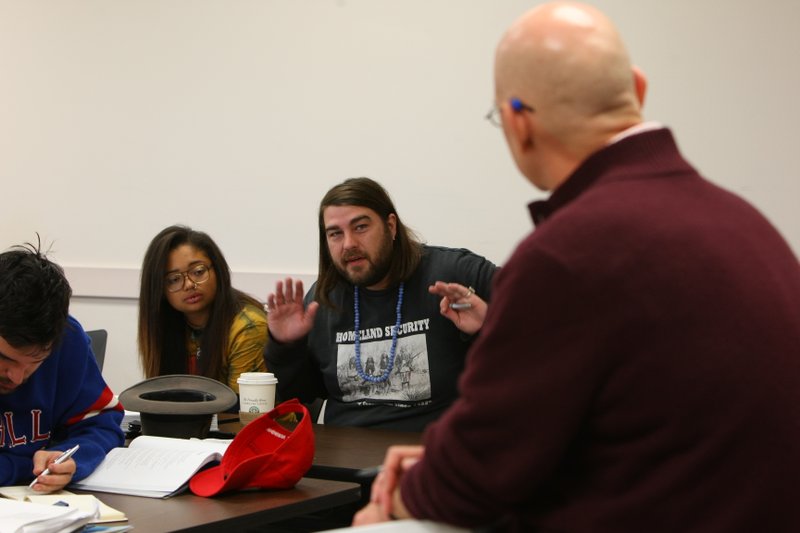LITTLE ROCK — A group of University of Arkansas at Little Rock students spent the fall semester listening to albums for homework, watching music videos in class and going to rock concerts - for credit.
Bob Dylan: Lyric Poetry, a literature course worth three credit hours, appeared in the UALR course catalog for the first time this fall.
Taught by associate professor of English Paul Yoder,students approached Dylan songs as poetry, analyzing the lyrics line-by-line like they would a poem by William Butler Yeats.
A child of the 1950s, Yoder grew up listening to Dylan protest songs on AM radio in the 1960s. In the 1970s, he attended Dylan’s famous Rolling Thunder Revue concerts, where musical pioneers like Stevie Wonder, Isaac Hayes and Carlos Santana joined Dylan on stage.
Yoder said he, like manyfans, lost interest in Dylan during the artist’s creative malaise of the 1980s and early 1990s. Yoder and Dylan reconnected, however, with the release of Dylan’s critically acclaimed Time out of Mind in 1997.
In the years that followed, the professor - who wrote a book on Romantic poet William Blake - started toying with the idea of a class involving deep readings of Dylan’s poetry.
The idea wasn’t new.
Harvard, Stanford and Boston University, just to name a few, all offer courses on Dylan’s works. Last spring, Arkansas State University at Jonesboro started a class on Dylan too.
The academic value of such courses has become easier to justify to skeptical department heads of late, Yoder said. Just last year, Dylan received a Pulitzer Prize Special Citation for his “lyrical compositions of extraordinary poetic power.”
The class also fit thematically with the introduction of UALR history courses on the 1960s and the Vietnam War.
While many of Dylan’s early works as a folk singer are relatively straightforward protest songs, his later albums are full of biblical references, rich imagery and obscure symbols.
“I’m a pretty good close reader of poems, and that’s the way I’m approaching the lyrics,” Yoder said. “Just the way he puts images together is what I’m really interested in. It’s not so much that it makes logical sense, but it does seem to make some sort of visceral sense.”
As for the class makeup, it’s largely a mixed bag.
There are preppies and hipsters, teenagers and the middle-aged, Dylan devotees and relative neophytes.
“There are some people who the first songs they heard are the ones played in class,” Yoder said. “On the other hand, some grew up listening to Dylan on their fathers’ knees.”
Junior Emily Andrews said the only Dylan song she knew before the class was “It Ain’t Me, Babe.”
Still, she knew he was a classic artist - a rock legend, akin to the Beatles - who “smart people” appreciated.
When the class came open, Andrews jumped on it.
“It’s like everyone should read Ernest Hemingway,” Andrews said. “Everyone should listen to Bob Dylan.”
The class meets twice a week.
Yoder - who won UALR’s Faculty Excellence Award for Teaching this year - keeps the atmosphere casual by starting each session with a Dylan track.
One November class began with a viewing of Dylan’s new music video “Must Be Santa,” a raucous song that mimics the repeating style of “The Twelve Days of Christmas.”
Each session focuses on one or two of Dylan’s albums.
For homework, students listen to the album ahead of time, write about it in a journal and post their thoughts online.
One student then writes a more in-depth review of each album and leads class discussion. Often, talks focus on a handful of songs, with an eye toward spotting overarching themes.
Senior Holland Colclasure led the analysis of Blonde on Blonde, the classic 1966 album that showcases Dylan’s early experiments with electric guitar and surreal lyrics.
Colclasure, who sports shoulder-length hair and skull-shaped rings, explained that the song “Leopard-Skin Pill-Box Hat” comments onAmerica’s changing perception of Jacqueline Kennedy during the 1960s.
The first lady was known for wearing conservative pillbox hats during John F. Kennedy’s presidency.
Symbolically wrapping it in leopard-skin print, however, reflected the country’s changing perception of her after her husband’s death, he said.
“The leopard skin is making her a sex symbol,” Colclasure said.
The students had the opportunity to experience Dylan live as well. The university paid for them to attend an October concert in either Tulsa or Springfield, Mo.
Classes wrap up this week. The students must produce a final paper where they pick three Dylan songs and discuss their thematic relationships.
Yoder said he’d like to teach the class again. If he does, he’ll ask the university to purchase Dylan’s discography so it’s available at the library.
As he told his students, there’s always more to be learned about Dylan.
“Part of the game here is you have to embrace the things you don’t know because Dylan is not explaining himself,” Yoder said. “He’s expecting you, I think, to be engaged with the stuff and be willing to go out on a limb for it.”
Arkansas, Pages 15 on 11/29/2009
